
Vere Gordon Childe, 1930
First Published: by Cambridge University Press, 1930
Mark-up: Steve Painter
The variety of tools, weapons, vessels and ornaments at the disposal of Bronze Age man was immensely greater than that known to his Stone Age forebears. It is the material expression of enrichment of life and extended control over nature. The enormous wealth of objects that have come down to us from this brief episode in human history renders possible a vivid picture of that phase of life. Still it is almost embarrassing to the archaeologist. Here we shall describe only the principal types of general interest, confining ourselves in the case of the Ancient East to varieties that have a special chronological or comparative value for students in North-western Europe.

The most widespread, and for typological chronology the most important, family of tools is conveniently termed celt. This designation is properly applied to axeheads, but is sometimes extended to adzes and even chisels of comparable form. The celt, whether used as an axe or an adze, was mounted on a wooden staff or shaft, the blade in the former case running parallel to the length of the shaft, in the latter at right angles thereto. The butt might of course be fitted directly into a slit in a straight shaft, but, in the case of all the European celts whose evolution is sketched below, it is certain that the so-called knee-shaft was employed[1]. This can most readily be obtained by cutting off a suitable bough or sapling just below the point where a branch grew out of it. This side branch was then broken off a couple of inches from its root and split. The celt was inserted in the cleft which was then bound round with sinews or wire (Fig. 9).

Axeheads and adze-heads of ground stone or flint had been in use throughout the Neolithic Age and indeed formed the most distinctive external trait of that epoch. The earlier metal celts very closely resemble the stone implements, some even reproducing the local peculiarities of the Neolithic celts from the same district. Nevertheless, some authors consider that polished stone celts are all really imitations of copper originals.
The simplest form of metal celt, therefore termed the flat celt, is in any case, like the stone implements, practically flat on both faces, and the sides are nearly but seldom quite parallel. Except in Egyptian examples the blade is generally slightly splayed out; this splay would be a natural result of the hammering necessary to sharpen the edge. Flat celts occur already in predynastic Egypt, prediluvian strata at Susa in Elam and in prehistoric cities on the Indus, as in the earliest metal-using cultures of Cyprus, Crete, the Cyclades and Greece. While most early Oriental specimens are made of copper, the form was reproduced in bronze at Troy and in the Aegean area generally. Simple flat celts are also characteristic of the “Copper Age” in Southern and Eastern Russia, Hungary, Italy, Sardinia, Spain and Ireland. They occur sporadically over a much wider area, even reaching Scandinavia, and are sometimes associated with stone celts (eg.in the Rhine valley) in hoards and quite often in settlements.
By the beginning of the local Bronze Age the outlines of the flat celt were
being modified in Europe. In the British Isles we meet with types whose butts
are very narrow in proportion to the wide curving blade (Fig. 12). In Bohemia
there is a variant with pointed triangular butt, probably an adze-head.
But by this time the typological evolution was already beginning. The first stage in the series is the flanged celt (Randleistenbeil, hache a rebords elevees) distinguished by ridges at the sides of either face. These flanges were doubtless in the first instance produced by the hammering on the sides that was in any case necessary after casting in an open mould[1A]. But they were useful in two ways, both giving the tool increased longitudinal rigidity (diminishing the risk of buckling in the sense of the blow) and preventing the head waggling on its shaft by gripping the prongs of the split branch.
That the value of such flanges was known at least to the ancient Egyptians is shown by a chisel strengthened in this way from the tomb of Hetepheres, the mother of the Pyramid-builder Cheops (Khufu),[2] but it was apparently never applied to celts in Egypt, Mesopotamia, the Aegean area or even Hungary and Southern Russia. On the other hand, flanged celts, even of copper, occur in Italian tombs, and in bronze they are characteristic of the Early Bronze Age in Italy, Czechoslovakia, Southern Germany, Britain and South-eastern Spain. By a mature phase of that period local variations are observable. Italian specimens always have a nick in the butt formed by leaving intact part of the two jets from the casting in a valve mould (Fig 20); in Bohemian and Central German types the butt is triangular. In the Middle Bronze Age the foregoing types persisted with divergent local variations in certain areas. In Scandinavia, for example, the body is rather long, the sides exactly parallel, and the flanges very prominent (Fig 24).
In Western Switzerland and the Rhone valley a type, based on Italian models, grew up distinguished by a great spatuliform blade. At the same time evolutionary improvements were being tried along three distinct lines.
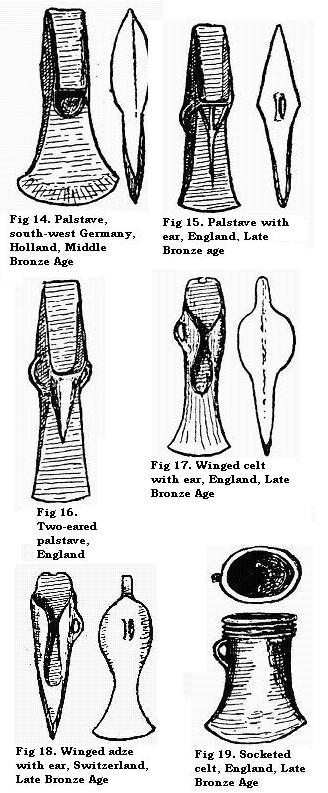 To diminish further the risk of side-slip a section of the flanges on either
face was widened to produce wings that could be hammered round the
shaft-prongs on either face. Thus arose the winged celt that was at home in
south-west Germany and Upper Italy. At first the wings are in the centre of
the implement (Fig. 21) ; towards the close of the Middle Bronze Age they
have retreated towards the butt. Then in the Late Bronze Age a loop or
ear is added for the thongs that lashed the tool on to its shaft, and the
section of the body below the wings is thickened, perhaps under the influence
of the palstaves (Fig. 17).
To diminish further the risk of side-slip a section of the flanges on either
face was widened to produce wings that could be hammered round the
shaft-prongs on either face. Thus arose the winged celt that was at home in
south-west Germany and Upper Italy. At first the wings are in the centre of
the implement (Fig. 21) ; towards the close of the Middle Bronze Age they
have retreated towards the butt. Then in the Late Bronze Age a loop or
ear is added for the thongs that lashed the tool on to its shaft, and the
section of the body below the wings is thickened, perhaps under the influence
of the palstaves (Fig. 17).
To prevent the axehead slipping back up the cleft of the shaft at each stroke and so splitting the knee-stick, a stop-ridge was developed between the flanges to engage the ends of the shaft-prongs. The rudiments of such a stop-ridge are observable on some Early Bronze Age flanged celts both in Great Britain and in Central Europe, but the fully developed palstave belongs to the Middle Bronze Age (Reinecke C) and is characteristic of Scandinavia, North-west Germany, France and Britain (Fig. 14). Subsequently the space between the flanges below the stop-ridge was filled up with metal in the casting, A reminiscence of the flanges is for a time preserved in the form of decorative ridges. Especially in Scandinavia one can see very pretty examples of “reminiscent decoration”. A tapering ridge is cast on each face of the palstave below the stop-ridge to simulate the prongs of the cleft shaft that had once projected downwards visibly on the faces of the tool. A rather later stage is denoted by the addition of an ear (Fig. 15). There is a group of palstaves with two ears, one on each side, in the Iberian Peninsula, Southern France and Sardinia. A few such palstaves have been found in the British Isles (Fig. 16), principally in the south and west. These are doubtless imports, but it is generally supposed that the palstave reached the Iberian Peninsula from Britain, It is nevertheless to be noted that implements with two lateral loops and exactly resembling the palstave in plan but flat on both faces are common in Sardinia.
The advantages of the winged celt and the palstave seem to be combined in a tool called by German archaeologists a Bohemian palstave. It probably grew up as follows. In Switzerland and Bavaria we find a sort of flanged celt that has been hammered so hard on the centre of each side that the body is narrowed while wings develop on either face (Fig. 22). The classical Bohemian palstave might result from imitating the product by casting, the section below the wings being again cast solid (Fig. 23). This form appears in Bohemia and Moravia during the Middle Bronze Age and was exported to neighbouring territories, particularly Hungary[3].
The natural culmination of all the previous developments was the socketed celt. It no longer requires the splitting of the shaft-end, eliminates side-slip almost entirely and provides a surface to engage the end of the shaft. In the Late Bronze Age this form certainly ousted all its predecessors. According to Montelius it was evolved from one of them, the winged celt. It is supposed that the wings grew till they met round the shaft prongs, forming a sort of tube divided by a septum (the body of the celt) in the middle. This was then eliminated and the end of the tube closed. It is true that some socketed celts, principally in Italy and Southern Germany where winged celts were current, exhibit semicircular ornaments cast in relief on either side (Fig. 26). These certainly imitate wings and, on the theory, are survivals thereof. However, in Hungary and Moravia the socketed celts, instead of the wing pattern, are decorated with ridges forming a V on either face that, just as obviously, reproduce the opening of a constricted celt. And in Scandinavia there are remarkable socketed celts with imitation flanges and a tapering ridge between them on the lower part of the blade (Fig. 25). These successfully reproduce the effect of a flanged celt, hafted, and bound round with a bronze collar. Sophus Muller[4] indeed contends that the Danish socketed celt was evolved thus out of the flanged celt with attached bronze collar without the intervention of the winged celt.
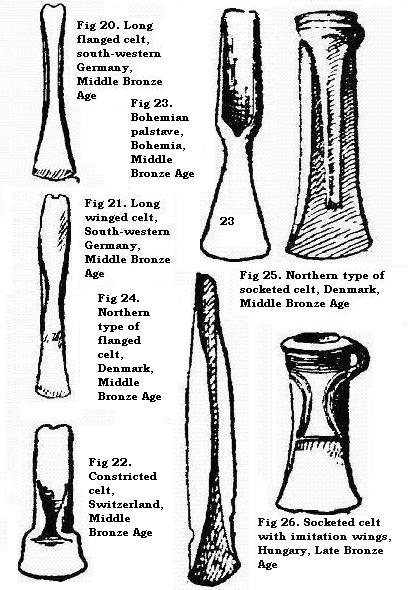 None of these a priori theories can be accepted. The imitative patterns invoked
by Montelius and Sophus Muller were not introduced by the ancient
smiths in pious memory of effete devices, but to make a new type of tool look as like as possible the accustomed model of each region, a model
with which it was in active competition. Quite possibly the origin of
the socketed celt is to be sought outside Europe. There were in Mesopotamia
cutting tools, adzes rather than axes, made out of a sheet of metal whose
sides were folded round so as to form a tubular socket. Similar implements are
known from South Russia, and in the Evans Collection at Oxford is a
socketed gouge from Dalmatia formed on this principle.
None of these a priori theories can be accepted. The imitative patterns invoked
by Montelius and Sophus Muller were not introduced by the ancient
smiths in pious memory of effete devices, but to make a new type of tool look as like as possible the accustomed model of each region, a model
with which it was in active competition. Quite possibly the origin of
the socketed celt is to be sought outside Europe. There were in Mesopotamia
cutting tools, adzes rather than axes, made out of a sheet of metal whose
sides were folded round so as to form a tubular socket. Similar implements are
known from South Russia, and in the Evans Collection at Oxford is a
socketed gouge from Dalmatia formed on this principle.
The centre where European socketed celts were first made has not been exactly determined. The oldest actual examples would be some Danish ones assigned to the Middle Bronze Age. In general the socketed celt belongs to the Late Bronze Age.
The Egyptians, owing probably to the kinds of timber available, did not fix their axeheads into a split stick but bound them on to a shaft by lashings round and across the head. To facilitate attachment, lugs, continuing the line of the butt, grow out of it on either side by Middle Kingdom times if not before[5] (Fig. 28). Stone axeheads of the same form have been found in Egypt, Central Asia and America.
Adzes in general follow the same lines of evolution as the foregoing types of axeheads. The adze may be narrower and sometimes there is a difference in the slope of one face[6]. Take a cross-section along the length of the implement and draw an imaginary line from the blade to the middle of the butt. Then in an axe the angles made by the two faces with this line must be equal, otherwise each blow will go crooked. In an adze no such symmetry about the major axis is necessary. The real distinction between an axe and an adze is, however, the method of hafting, which can seldom be determined from an inspection of the head. Almost any form of celt could be converted into an adze by merely turning the blade through a right angle, eg in the case of a knee-shaft by splitting the spur at right angles to the main branch instead of in a line with it. Still in Europe the transverse hafting of the celt to make it do duty as an adze was falling into desuetude in the later part of the Bronze Age. To avoid it the smiths cast palstaves and late winged celts in which the blade was at right angles to the concave faces that received the haft's prongs (Fig. 18).
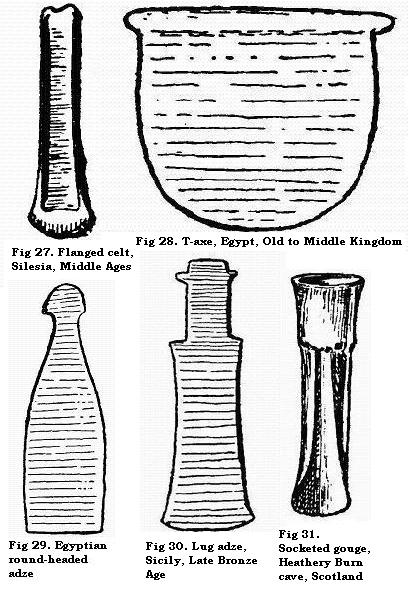 In addition to these simple variants on the axehead, we should note here one
or two peculiar types of celt that generally served as adzes. The
proto-dynastic Egyptian adzes and one or two Elamite examples have rounded
heads (or butts). Under the Old Kingdom and still more in Middle Kingdom
times this rounded head was separated from the body by a marked concave neck
(Fig. 29).
In addition to these simple variants on the axehead, we should note here one
or two peculiar types of celt that generally served as adzes. The
proto-dynastic Egyptian adzes and one or two Elamite examples have rounded
heads (or butts). Under the Old Kingdom and still more in Middle Kingdom
times this rounded head was separated from the body by a marked concave neck
(Fig. 29).
In the earliest Indian chisels[7] the blade expands slightly till about one-quarter of its length from the butt, then contracts abruptly after a sharp shoulder only to expand again towards the edge. Some adzes of this pattern have been found in Late Minoan Crete and elsewhere in the Eastern Mediterranean region. A flat celt, developed from this type, in which the neck makes a right angle with the shoulders is common in Late Bronze Age hoards in Sicily and Southern Italy. From it grows the trunnion celt or lug-adze where the shoulders have become definite lugs, projecting on either side, a type belonging for the most part to the Hallstatt Iron Age. Its growth, however, interlocks with that of the Sardinian flat celts with two lateral loops already mentioned in discussing palstaves.[8]
Like the adzes, the chisels follow closely the evolution of the celt; the essential feature is the narrowness of the blade. We thus have flat chisels, flanged chisels, flanged chisels with a stop-ridge (very narrow palstaves) and socketed chisels as well as lugged chisels. Late in the Bronze Age of Italy, France and Great Britain tanged chisels appear, probably developed out of shouldered chisels such as we found in most ancient India[9]. The earlier variant, found even with palstaves, closely resembles the square-shouldered adze in outline, though the whole tool is naturally more slender, the tang relatively longer and more tapering, while the blade expands very markedly. In the latest Bronze Age the tang is not only narrower but also thinner than the portion below the shoulder; in fact it projects from a flat surface which would engage the end of a tubular wood or bone handle in which the implement must have been held (Fig. 33).
Gouges are just chisels with a hollow edge. Implements of this type are known in stone from the Balkans and Russia and in flint from Scandinavia. Copper chisels with a concave blade are known very early in Mesopotamia, from Troy II and from Copper Age graves in South Russia. True socketed gouges, resembling socketed chisels with a concave blade, are very common in the Late Bronze Age all over Europe. But it will be remembered that gouges with the sockets formed by rolling over the metal to form a tube have been found in a Dalmatian hoard. In general it should be noted that socketed chisels and gouges spread more rapidly and earlier than socketed celts (axes). For example, a lake village at Alpenquai near Zurich yielded five socketed chisels and one socketed gouge but no socketed celts; their place was taken by twentyseven examples of the supposedly older winged type.
It is curious that the modern type of axehead that fits on to, not into, the shaft had a very limited distribution down to the later Iron Age. The expedient of providing a hole in the axehead, parallel to the blade, was indeed known in Mesopotamia in prediluvian times[10]. It was also adopted in Crete and the Aegean islands, in Hungary and Russia at the beginning of the Metal Age in each area and occasionally in Scandinavia, Sicily, Southern Italy, Sardinia and Anatolia. On the other hand, this practical type of metal axehead was, apart from stray imports, never adopted in Egypt nor yet in any part of Central or Western Europe till late in the Iron Age. Even in Hungary the shaft-hole axe was practically ousted by the socketed celt in the Late Bronze Age.
The shaft-hole axe is apparently a Sumerian invention. Certainly before 3000 BC the Sumerians were casting excellent axeheads with a tube for the shaft reinforced by rings around it and a ridge at the back opposite and parallel to the blade (Fig. 34). Of course the manufacture of such an axe required the use of a two-valve mould and a movable core; probably the ridge at the back was originally suggested by the seam, though in practice enlarged to give additional strength at a weak point. Allied types were soon adopted also in Syria. There and in Mesopotamia a curious battle-axe with a very narrow blade was in use during the third and second millennia. The South Russian and Hungarian copper axes for the most part resemble the Sumerian in having a tubular shaft-hole clearly distinguished in profile from the blade (Fig. 36). Viewed from above, however, it is seen that the sides of the blade (meeting naturally at the edge) form tangents to the shaft-hole. This peculiarity they share with the early Aegean axes. But such have no tubular extension round the shaft-hole and so look rather like extravagantly thick celts with a perforation joining their sides near the end. The Sicilian and some Russian types conform to the Aegean pattern. The Hungarian axes of the Middle Bronze Age, however, are extraordinarily like mature Mesopotamian types.
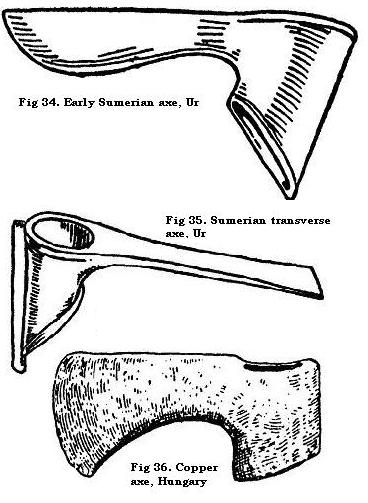 TRANSVERSE AXE: SHAFT-HOLE ADZE
TRANSVERSE AXE: SHAFT-HOLE ADZESide by side with the weapon described at the beginning of the last paragraph, the inhabitants of the Tigris-Euphrates valleys from the earliest historical periods to the beginning of the Iron Age used an implement identical with the foregoing in respect of its tubular shaft-socket but with the blade turned at right angles to the shaft (Fig. 35). This odd type was confined to Babylonia and Assyria with the exception of one specimen from a grave in the Kuban valley north of the Caucasus and one from Syria.
The Minoans of Crete preferred an axe with two blades in the same plane and the shaft-hole midway between them. This weapon, which was possibly derived in the last resort from Mesopotamia, became a cult symbol in the Minoan religion and was in practical use throughout the Aegean world from Early Minoan times. There are isolated examples from Hungary, South Russia and Sardinia, the latter with a tubular extension of the shaft-hole. In France, Switzerland and Germany a few double-axes of copper are known whose central perforation is too small to take a real shaft. They must then be symbolic and perhaps served as ingots or units of weight. In the same connection we may mention an odd implement manufactured in Saxo-Thuringia during the Early Bronze Age. It resembles a double-axe in having two rather blunt blades in the same plane and a shaft-hole between them, but its edges are absurdly narrow.[11]
In the Aegean[12] we find from Early Minoan times a tool resembling a double-axe in which one blade has been twisted round till it lies transversely to the shaft and the other blade (Fig. 38). A similar type is known from Persia and there is an example from the Kuban which, owing to the character of the shaft-tube, looks exactly like a combination of the two Sumerian axe-types on a single shaft. Axe-adzes are distinctive of the Copper Age of Hungary.[13] Here, it is said, the shaft-hole has not been made by casting but by punching through the red-hot metal. Later the implement reached Sardinia, perhaps from Hungary since the Sardinian examples all have a short tubular projection round the shaft-hole, a feature noticeable on many Hungarian specimens (Fig. 39) but strange to the Aegean series. Contemporary with the axe-adzes in Hungary was a sort of axe-hammer that might have been made by breaking off the transverse blade of an axe-adze near the shaft-hole.
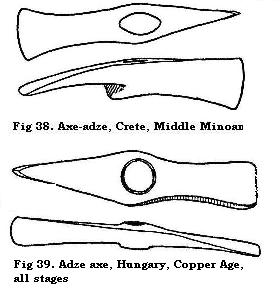 BATTLE-AXES
BATTLE-AXESThis designation is conventionally restricted to a group of axes with spikes or knobs for the butts that are virtually confined to Hungary and Scandinavia. In Hungary there are two main types: in one the blade expands slightly towards the edge while the butt terminates in a disc. During the Middle Bronze Age this disc is flat or slightly convex; in the Late Bronze Age a large spike projects from it. The other type, confined to the Middle Bronze Age, has a very narrow blade, a long tube for the shaft and a fan-shaped butt. Both types may be richly decorated with engraved scroll patterns. The comparatively rare Danish battleaxes are considerably more massive and generally have a knobbed butt. The majority belong to the Middle Bronze Age and are ornamented with engraved spirals.
Almost more important for typological chronology than the celts are the daggers, rapiers and swords. The first-named weapons, many of which also served as knives, were current from the beginning of the Metal Age throughout the Old World. The important features in the dagger are the shape of the blade in plan, the provision made against crumpling up under the weight of a thrust (securing longitudinal rigidity) and the attachment of the hilt. The most primitive form of dagger has a roughly triangular blade that is nearly flat on both faces. Triangular daggers are as a rule extremely short, very rarely attaining a length of six inches. Any increase in the length must be accompanied by an inconvenient widening of the base if the weapon was not to buckle under the weight of the thrust, unless the increased length were counterbalanced by a thickening of the blade. And, as the dagger was a stabbing weapon, the weight of the blade had to be kept down to preserve the proper balance. A considerable increase of length was, however, possible if the edges were kept parallel for some distance below the hilt before tapering off to a point. This produced the so-called ogival dagger (Fig. 46) Both types could be cast in an open mould.
An extension of the blade without undue increase in width, thickness or weight was, however, permitted by casting a thick stout ridge running down the centre of course in a two-piece mould. This central ridge is termed a midirib and greatly diminished the danger of buckling without affecting the penetrating power (Fig. 43-44).
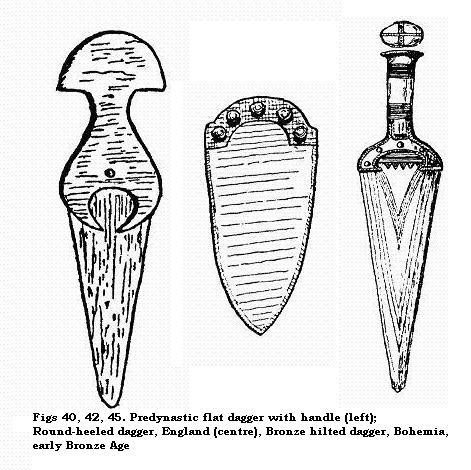
All daggers were provided with hilts of wood, horn, ivory or metal. Except in certain Copper Age types the hilts were affixed to the blades by rivets. The hilt, consisting either of a single piece, slitted longitudinally to slip over the blade, or of two pieces, united by nails or lashings, might be attached directly to the butt of the blade or on to a tongue-like projection of the latter, termed a tang. This gives a distinction between tanged and tangless daggers. The tang may be either wiry, in fact a sort of prolongation backwards of the mid-rib, or flat, but is always narrower than the butt from which it projects like a neck with shoulders on either side. The butt or heel may be either a straight line along the widest part of the blade forming the base of the triangle, or a triangular, trapeze-shaped or semicircular projection of the blade behind that line. When neither rivets nor tang were employed to secure the hilt, the backward projection of the blade had to be relatively long to prevent waggling. In a curious Copper Age dagger from Western Europe (Fig. 41) it is so long as to resemble a tang, but, since its edges form continuous lines from the base of the blade proper, this type should be assigned to the tangless class. In Egyptian tangless daggers, most Aegean types, and all continental European models the broad base of the hilt enveloped the butt on either side leaving a semicircular space in the middle (Figs. 40, 42, 45). This feature is traceable even on the hilts of flint blades in predynastic Egypt. It is conspicuous on bronze-hilted blades in Europe (Fig. 45) and is recognisable on many others, whose hilts have perished, by the marks they may have left a feature always to be looked for as soon as the blade is found. In the case of Asiatic daggers, which are nearly always tanged, no similar overlapping is observable. Often, however, a metal ferrule is fitted over the butt of the blade and the base of the hilt to mask and strengthen the join.
The earliest known Egyptian dagger, dating from Middle Predynastic times, is
flat and triangular with a triangular heel, so that the blade as a whole
is rhomboid. The earliest Mesopotamian daggers, on the contrary, are tanged and
generally strengthened with a midrib (Fig. 43). Very early specimens are already ogival in outline. Throughout Asia Minor as far as Troy
II daggers of the same general pattern are current.
In Crete some Early Minoan daggers are flat and reminiscent of predynastic Egypt, but the midrib was soon employed, and examples with a broad, flat tang are quite early. The midrib was very pronounced also in Cypriote and Cycladic daggers. In Cyprus a very curious form grew up in which the midrib was prolonged into a long tang bent over at the top (Fig. 44). The type, which appeared already in Early Aegean times and lasted till the Late Mycenaean period in the island, was exported to Palestine, Syria, Anatolia and Hungary.[14] Weapons, of very similar form but with slits in the blade, as if they had been hafted as spearheads, are known from the Cyclades and Troy II.[15]
In Middle Aegean times ogival daggers were in use both in Crete and by the Minyans of Greece. In MM I deposits we meet a tanged ogival dagger with slight flanges round the shoulders and bordering the tang. It formed the starting point for an important series of daggers and rapiers of later Minoan times. The flanges, of course, served to keep in place the plates of wood or ivory that formed the grip of the hilt.
The regular series of continental European daggers begins in the Early Bronze Age with a small flat triangular round-heeled blade, often adorned with groups of grooves parallel to the edges (Fig. 42). Before the end of the period such weapons were being provided with hilts of bronze, cast separately, in North Italy, the Rhone valley and Central Europe (Fig. 45). In Germany imitations were manufactured with hilts cast in one piece with the blades. From Brittany and England a couple of contemporary daggers have survived whose wooden hilts were studded with hundreds of tiny gold nails.
During the Middle Bronze Age an ogival dagger or short sword was evolved out of
the foregoing types in the Rhone valley, preserving their
characteristic decoration, rounded heel and flat section. The standard
Central European type of this period, however, may have had a different
origin, for it has an angular trapeze-shaped butt, and often a distinct, if generally broad and low, midrib and lacks
all ornamentation (Fig. 46). In the earlier specimens[15] the
heel is relatively broad and carries six rivets ; later it is narrowed down and
the number of rivets reduced till in the Late Bronze Age only two
survive. In the latter period, too, a few specimens with flanged tangs,
inspired by Mycenaean models, appear.
Rapiers, as noted, appear to be an Aegean invention. Orientals shrank from the close fighting in which alone such weapons are useful, while the continental barbarians of Europe lacked as yet the metallurgical skill necessary for their forging. The earliest known rapier, recently found at Mallia in Crete and dating from MM I (circa 1950BC) is over 90cm long. The blade has a stout, wide midrib. The hilt, of ivory plated with gold, meets the blade in a slightly convex line (an Asiatic as opposed to Egyptian feature) and is surmounted by a long pear-shaped pommel of crystal (also very Sumerian looking.[16] The regular Minoan series only begins some centuries later with the Shaft Graves of Mycenae belonging to the close of MM III (about 1600BC). By that date three distinct types are known: (I) a relatively flat blade of elongated ogival outline with a flat tang (Fig. 47); huge tapering blades with a skewer-like midrib terminating either, (IIa) in a round heel from which projects a short narrow tang (Fig. 48), or (II ) in a square butt with wider tang, both shoulders and tang being flanged (Fig. 49). All were balanced by heavy pommels of crystal or semi-precious stone to receive which a spur projects from the tang of IIb. The latter 's grip consisted of plates, let in between the hilt's flanges and held in place by large gold-capped rivets. The grip of IIa was supported by gold mounts fitting over the heel. These already have projections at the shoulder serving as guards to divert from the gripping hand the adversary's weapon when the rapier was parrying a thrust. A short length of the edges, just below the butt, was intentionally blunted so that the thumb and forefinger of the swordsman's hand might rest there a feature (known as the ricassodi).
Later, the flanges on the shoulder of type IIb were developed into lateral
horn-like (LM II and LM. IIIa) or cruciform (LM. III) projections
likewise serving as guards[17] (Fig. 50). Late in LM IIIa, too, the
flange was carried right round the hilt so as to support also the
pommel. One or two rapiers of the last-named variety have been found north of
the Alps towards the close of the Middle Bronze Age.
The continental European rapiers that begin in the Middle Bronze Age might be regarded as mere prolongations of the ogival dagger. The early specimens have six rivet-holes for the attachment of the hilt (Fig. 52). Such weapons, which rarely reach a length of 60cm, are common in Central Europe and Scandinavia and even reach Great Britain. In the latter country two-piece moulds for their manufacture have actually been found. As in the case of the daggers, the butts of these weapons grew narrower as time went on, yielding in the Late Bronze Age a form with a tapering butt and three rivet-holes, well represented in South-west Germany, Switzerland and France and occurring sporadically in Hungary and Italy (Fig. 53). A contemporary Italian and French variant has a rod-like tang terminating in a hook rather like a Cypriote dagger. The above series was, I believe, inspired by Aegean models. Yet in South-eastern Spain we find, associated with Early Bronze Age celts and daggers, a short flat sword that is clearly just a magnified dagger, preserving the comparatively flat section and round heel of the Early Bronze Age type.[18]
Some of the above-mentioned rapier types in Italy, Central Europe and Scandinavia are provided with bronze hilts, cast on, or cast in one piece with, the blade. Early in the Middle Bronze Age (Reinecke B) the hilts are cylindrical or, in South-west Germany, concave (Fig. 54). Later in the same period (Reinecke C) a type with octagonal hilt, richly decorated with engraved patterns, arose in the Upper Danube basin. Contem- porary Danish sword-hilts are superbly decorated with inlaid spiral patterns. Still later (Reinecke D) the hilts begin to swell out in the middle, but concurrent changes in the shape of the blade indicate that we are now dealing with a new weapon, the cut-and-thrust sword.
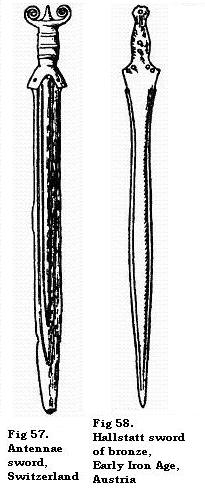 All the weapons hitherto described were designed primarily for thrusting. None
the less some of the bronze-hilted types from Scandinavia and Central
Europe could also be swung. A real sword that can slash as well as thrust must
have its centre of gravity shifted towards the blade, while for
thrusting the weight had to be in the pommel. Certain long wide blades with a
bulge half-way up and a short flat tang, found in Denmark, North Germany,
Western Hungary and Upper Italy, seem to be aiming at this result. But a stroke
imposes much greater strain on the joint between hilt and blade than
does a thrust. The short-tanged type just described could no more grow into a reliable sword than the round- or
square-heeled rapier.
All the weapons hitherto described were designed primarily for thrusting. None
the less some of the bronze-hilted types from Scandinavia and Central
Europe could also be swung. A real sword that can slash as well as thrust must
have its centre of gravity shifted towards the blade, while for
thrusting the weight had to be in the pommel. Certain long wide blades with a
bulge half-way up and a short flat tang, found in Denmark, North Germany,
Western Hungary and Upper Italy, seem to be aiming at this result. But a stroke
imposes much greater strain on the joint between hilt and blade than
does a thrust. The short-tanged type just described could no more grow into a reliable sword than the round- or
square-heeled rapier.
True swords seem to begin in a tanged blade whose flat tang and round shoulders are bordered with flanges, as in the Minoan rapiers classed as type II a. The form is certainly inspired by rapiers of this family, but the northern and Italian blades in question differ from the Aegean in that the edges are nearly parallel instead of tapering, and the midrib wide and flat so as not to impede a cut (Fig. 55). In what Kossinna[19] regards as the earliest type, appearing in Denmark according to Sophus Muller[20] in his period 2, there are no rivet-holes in the tang though there may be four in the heel; lead solder was sometimes used to keep in place the horn plates of the grip. This type occurs principally in Scandinavia, North-eastern Germany and Upper Italy. Some Central European swords with rivet-holes in the tang can hardly be later. They begin in the closing phase of the Middle Bronze Age and flourish in the Late Bronze Age. During the latter phase the blade tends to widen out to a leaf-shape a barbarous weapon adapted almost exclusively for hacking. In late versions (Reinecke E) nicks are seen just below the shoulder to guard the thumb and forefinger resting on the blunted edge (ricasso) above[21]. Others, however, say that the nicks served to prevent the blade joggling out of its scabbard. Sometimes also a spur projects from the end of the tang to hold the pommel. In some West European swords, belonging to a period subsequent to the pure Bronze Age, some of the rivet-holes are replaced by slits. In many of these West European swords the lower end of the blade has been narrowed down, apparently by filing away part of a leaf-shaped blade, with a most curious effect like a carp's tongue.
Early versions of the flange-hilted leaf-shaped sword without any ricasso or even marked swelling in the blade are very common in Northern and Central Europe, Styria, Carniola and Bosnia and, as already remarked, even reached Greece and Egypt before 1200BC.[22] The immense majority of the late versions, however, come from west of the Rhine, particularly from France and Britain. In the latter country they, with other exotic types, characterize the local Late Bronze Age which is really largely contemporary with the Early Iron Age of Central Europe. There, early in the Hallstatt period, our bronze swords had undergone a further modification, losing altogether the flanges round the hilt and acquiring instead a widened extension thereof to take a conical pommel. This is the true Hallstatt sword, represented by only a few stray examples in Britain (Fig. 58).
Parallel to the flange-hilted sword go certain developments of the bronze-hilted rapiers whose blades have been assimilated to the leaf-shaped order. Two important types with a swelling bronze grip of flattened oval cross- section were developed in Switzerland. In one variant, termed the antennae sword (Fig. 57), the pommel consists of a stout bronze ribbon bent into opposing spirals. The type is common on both sides of the Alps and is found eastwards as far as Macedonia and Slovakia, northwards into Scandinavia and westwards as far as Lincolnshire. The other Swiss sword, known as the Morigen or Ronzano type, has a pommel shaped like an oval saucer (Fig. 56). Both types begin in the latter half of the Late Bronze Age, Reinecke E, and last into the succeeding phase of the Iron Age. Contemporary with them in Hungary went handsome swords with a swelling grip decorated with raised bands (representing the thongs that bound the plated hilts of the tanged swords) and surmounted with flat or saucer-shaped pommels. Such swords were exported from Hungary to Upper Italy, Eastern France, the Rhine valley and Eastern Galicia.
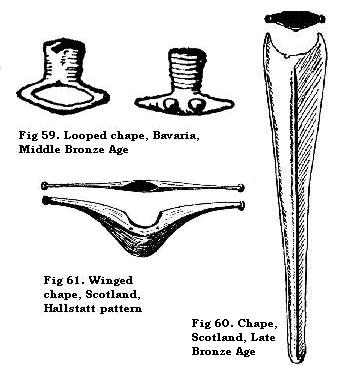 CHAPES
CHAPESThe rapiers and swords just described were normally carried in wooden sheathes which have naturally perished. We possess, however, some of the bronze chapes in which the scabbards terminated. The Middle Bronze Age chapes resemble little diamond-shaped snuffboxes or end in a loop (Fig. 59). The Hallstatt scabbards, on the contrary, ended in weird “winged” chapes, a few specimens of which reached Britain (Fig. 61). The type more common in Britain and France resembled the last named but was longer and lacked the great lateral wings (Fig. 60).
The halberd is a peculiar weapon, distinctive of the Early Bronze Age in certain parts of Europe. It is essentially a triangular dagger hafted at right angles to a staff. Indeed a halberd can often be distinguished from a dagger only by observing that the mark left by the haft runs across the blade. Frequently, however, the halberd blade is asymmetrical, ie the triangle that would enclose it is scalene and not isosceles (Fig. 63).
The weapon is believed to have originated in Southern Spain or Portugal, since certain flint blades found on Copper Age sites there may be best explained as halberds. It is in any case a regular element in the furniture of Early Bronze Age graves along the South-east coast of the peninsula; thence it seems to have reached Upper Italy, since a few specimens have been found there, and the weapon is depicted, brandished by warriors, on the rocks of the Ligurian Alps. Finally, there is one specimen, markedly asymmetrical and much incurved on the lower edge, from Shaft Grave IV at Mycenae. This halberd, though doubtless inspired by the western group, was a local product since its big rivet-heads have been gilded.[23]
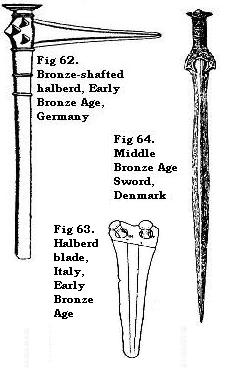 Westward from Spain the device was transmitted across the Atlantic to Ireland.
A large number of specimens, mostly of copper, are known from the
island. Many have a peculiar scythe-like outline. From Ireland a few halberds
reached England and Scotland. Thence the type journeyed across the North
Sea and up the Elbe where it was adopted in Saxo-Thuringia. Some early halberd
blades here are decorated with incised lines like the contemporary
daggers. Subsequently a localised variant was created: the haft was sheathed
in metal and its head enveloped in a bronze cowl into which the blade was
fitted. At first the blade was attached by rivets; in later specimens the cowl
has been cast on but shows imitation rivet-heads moulded on its surface
(Fig. 61). These Central German halberds found their way, presumably by
trade, to Sweden, Lithuania and Slovakia. But the weapon was never
adopted in Silesia, Czechoslovakia, Hungary, South-western Germany or France.
Westward from Spain the device was transmitted across the Atlantic to Ireland.
A large number of specimens, mostly of copper, are known from the
island. Many have a peculiar scythe-like outline. From Ireland a few halberds
reached England and Scotland. Thence the type journeyed across the North
Sea and up the Elbe where it was adopted in Saxo-Thuringia. Some early halberd
blades here are decorated with incised lines like the contemporary
daggers. Subsequently a localised variant was created: the haft was sheathed
in metal and its head enveloped in a bronze cowl into which the blade was
fitted. At first the blade was attached by rivets; in later specimens the cowl
has been cast on but shows imitation rivet-heads moulded on its surface
(Fig. 61). These Central German halberds found their way, presumably by
trade, to Sweden, Lithuania and Slovakia. But the weapon was never
adopted in Silesia, Czechoslovakia, Hungary, South-western Germany or France.
While metal was scarce, missile weapons would naturally be tipped with flint or horn points. At the same time the shorter forms of dagger could easily be converted into lance-heads by attachment to a long shaft. A blade intended specifically for a spearhead, however, would rather have the shape of a laurel or willow leaf. Some sort of tang was usually needed to facilitate union between the blade and the shaft. In Mesopotamia,[24] where the shafts (or at least the foreshafts) were normally made from hollow reeds, the tang was narrow and projected from a marked shoulder at the base of the blade that would engage the outer edge of the reed. The tang in the most popular variant is rectangular in section and tapers off below like a modern poker point. Hence the name “poker-butted spearhead” (Fig. 65). The type begins in Sumer before 3000BC and is found also in Elam, North Syria and beyond the Caucasus. In South Russia it persisted throughout the Copper Age into the belated Late Bronze Age (contemporary with the Hallstatt period).[25]
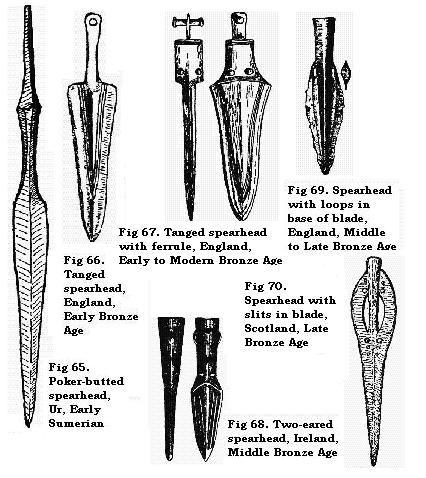 In Egypt a specialised spearhead of metal first appears in early dynastic
times.[26] The one specimen known to the author seems really to conform to
the tanged pattern, though it is very rough, but is distinguished by a very
broad ferrule of sheet copper that originally encircled both the split end
of the shaft and the contained tang. But metal spearheads are very rare in
Egypt till New Kingdom times.
In Egypt a specialised spearhead of metal first appears in early dynastic
times.[26] The one specimen known to the author seems really to conform to
the tanged pattern, though it is very rough, but is distinguished by a very
broad ferrule of sheet copper that originally encircled both the split end
of the shaft and the contained tang. But metal spearheads are very rare in
Egypt till New Kingdom times.
In the Cyclades during the Early Aegean period the shaft of split wood projected a long way down the blade, to which it was attached by thongs. A pair of slits were accordingly left in the blade to receive the bindings.[27] From the islands the type spread to Troy II and across the Greek mainland to Levkas.[28] Towards the close of Middle Helladic times this slitted spearhead gave birth to an odd form, confined to mainland Greece, in which the tip (or perhaps half the tip) of the shaft fitted into a shoe-like socket cast on one face of the blade. The principal development of the spearhead in the Aegean, however, starts with an Early Minoan type ending in a broad flat tang originally riveted into the shaft. During Middle Minoan times a tubular socket was formed by bending the edges of the tang round a mandril. The tube was later strengthened by forcing a cast ring over its lip.
In Britain there are some kite-shaped blades of Early Bronze Age date terminating in a long, narrow, flat tang (Fig. 66). In at least one instance a ferrule had been fitted over the end of the shaft in which the tang was embedded so as to project over the blade (Fig. 67). Greenwell has suggested that a true socketed spearhead then developed through casting the ferrule in one piece with the blade and suppressing the tang[29]. The Arreton Down type of spearhead (so- called from a hoard found at that place in the Isle of Wight) conforms exactly to what might have been expected to result from this process. The majority of British spearheads of the Middle Bronze Age, however, agree with contemporary continental types. The blade is shaped like a laurel leaf, and the tube of the socket (formed by core-casting) extends well into the body of the blade and is continued externally as a midrib to the point. This form of head appears in Scandinavia, Central Europe, Hungary and Italy at the beginning of the Middle Bronze Age. In the Late Bronze Age it tended to give way to a form with lanceolate blade. Both types were secured to the shaft by a pin through a hole in the socket.
In Britain evolution followed different lines, a pair of loops developing on the socket through which thongs wrapped round the shaft could pass. These thongs took the place of rivets. In the earlier examples, associated in hoards with the older group of palstaves, and so of Middle Bronze Age date, the loops stand near the mouth of the socket (Fig. 68). This type is purely British, the few examples from North France being certainly imports from across the Channel, though single-eared spearheads occur in the “Copper Age” of South Russia. Later the loops approach the base of the blade and finally join on to it (Fig. 69). Examples even of the last phase are associated with rapiers. In our Late Bronze Age the loops have become either small eyelets near the base of the blade or semicircular slits, generally in the swelling part of a lanceolate blade. The small eyelets may still have had the same functional value as the ancestral loops. They can be paralleled on Sicilian and South Italian spear-heads of bronze belonging there already to the Early Iron Age. The curious semicircular openings (Fig. 70), however, can hardly have been designed for receiving binding thongs; there is in fact generally a rivet-hole in the socket of such spearheads. The type doubtless originated in the British Isles though a derivation from the Early Cycladic slitted form has been suggested by Coffey.[30]0 From Britain specimens were exported as far as Huelva in Spain,[31] and the type somehow reached Central and Southern Russia. The idea was adopted and imitated there, moulds for the manufacture of the local variant having been found in the Ukraine.[32]
Metal could only be used for arrowheads when it was very cheap. Actually flint and bone arrowheads remained current nearly everywhere throughout the Bronze Age. In Egypt and Crete flint lunates were employed to form transverse heads. In Middle Helladic and Mycenaean tombs we find superb hollow-based (barbed) arrowheads of flint or obsidian, and cruder variants on the same form are common in the Late Bronze Age urnfields of Central Europe. The finest stemmed and barbed arrowheads of Britain and France belong exclusively to the Bronze Age. Barbed bone tips are also found in the Late Bronze Age of Italy and Central Europe.
Barbed metal arrowheads of various patterns but always with a long tapering tang are known from Egypt, Mycenaean Greece and Central Europe during the Middle and Late Bronze Age. In the last-named area the spur-like tang gradually gave way to a tubular socket. The Early Bronze Age graves of South-eastern Spain have yielded a peculiar barbless form with broad leaf-shaped head and a long tail-like tang. It must be remembered that bronze was still used for arrowheads quite late in the Iron Age.
Many flint knives of the Stone Age had probably been simply backed with wooden handles. Ground stone knives mounted in the same manner are known in Eastern Europe and Asia. A translation of such into metal would be just a strip of copper sharpened along one side by hammering. Such knife-blades with one or two rivet-holes in the back have actually been found in England, France and Central Russia, but generally in a Late Bronze Age context.
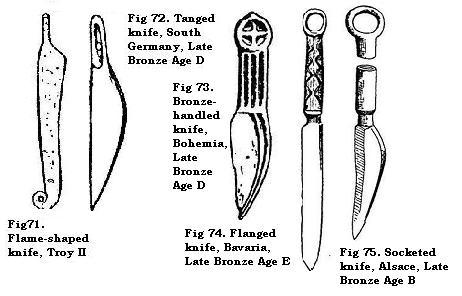 Such tools were extremely clumsy, yet it was no easy matter to attach a
single-edged knife to a handle so that it should not waggle when pressure was
put upon it, Hence single-bladed knives are a late feature. An early group,
represented in Old Kingdom Egypt[33] and Troy II,[34] solved the problem
by prolonging the back of the blade to form a narrow tapering tang on to which a tubular handle of
wood or bone was fitted (Fig. 71). In Greece such implements do not
appear before Middle Aegean times. Then the hilt was attached by from three to
five rivets (not all in a straight line) to a wide butt without the use
of a tang.[35] Later a broad tang was used to support the handle.
Such tools were extremely clumsy, yet it was no easy matter to attach a
single-edged knife to a handle so that it should not waggle when pressure was
put upon it, Hence single-bladed knives are a late feature. An early group,
represented in Old Kingdom Egypt[33] and Troy II,[34] solved the problem
by prolonging the back of the blade to form a narrow tapering tang on to which a tubular handle of
wood or bone was fitted (Fig. 71). In Greece such implements do not
appear before Middle Aegean times. Then the hilt was attached by from three to
five rivets (not all in a straight line) to a wide butt without the use
of a tang.[35] Later a broad tang was used to support the handle.
In Central Europe single-edged knives appear first towards the close of the Middle Bronze Age. All have arched backs, the handle being either attached by a rivet to a spur continuing the line of the back (Fig. 72) or cast in one piece with the blade. In the Late Bronze Age the variety of types is multiplied. The blade is either straight or recurved. The handle may be of bronze terminating in a loop and inlaid on either face with horn plates held in position by a series of metal tabs; alternatively a wooden handle was fitted into a tubular socket (Fig. 75) or, as in the previous period, on to a long spur (Fig. 76). In Switzerland was manufactured the curious variant of the latter group, with a section of solid metal where the ball of the hand rested, shown in (Fig. 77). The type, that belongs to Reinecke's phase E, was exported as far as Silesia, Hungary and Central France.[36]
In Great Britain single-edged knives are virtually unknown. But it must be
remembered that the short daggers could be, and doubtless were, used as
knives. They are indeed often termed, very properly, knife-daggers. In fact
some protodynastic Egyptian, Late Minoan and Early Bronze Age British “daggers” are rounded off at the point so that their use as daggers is excluded.
In the British Isles the round-pointed knives of the Early Bronze Age, that with their round heels and numerous rivets are so patently allied to the more pointed “daggers”, form the starting-point for two specialised knives of our Late Bronze Age. The first has a long blade and a short flat tang, nearly as wide as the blade, that generally bears two rivets (Fig. 78). The second, but that it is found associated with the first, might be regarded as evolved therefrom by the addition of a ferrule like the socketed spearheads of the Arreton Down class; for it is characterised by an elliptical socket with one or two pairs of rivet-holes, that looks just what might have developed out of such a combination with the hypothetical ferrule (Fig. 79). Such forms, though commonest in the British Isles and probably native there, are also found in Northern France and as far south as Charente.
Related to our socketed knives is a curious socketed instrument whose leaf-shaped blade is bent round in a semicircle. Outside Great Britain the type is found in Normandy and perhaps Switzerland (Fig. 80).
It is quite possible to shave with a flint blade, and some predynastic flints were undeniably utilised in this way. The early Egyptian metal razors exactly copy these flint forms. One type, confined to the Early Dynastic period, was rectangular with four bevelled edges. Another form, going back to Late Predynastic times, looks like a broad double-edged knife with a short tang. Probably most were sharpened along one edge only, as is certainly the case with the specimens from Queen Hetep-heres' tomb. A very similar little implement has recently been found in early Sumerian tombs. The Mesopotamian razors, always unfortunately in bad preservation, are regularly found in pairs; it is uncertain whether both edges were sharp. In the Aegean area the earliest certain razors date from the LM III period. The majority are one-edged (Fig. 81) but there are double-edged specimens in which the handle was riveted directly on to the blade without a tang.
The majority of European razors belong to the same family. In the earlier
graves of the so-called Siculan II period, containing Mycenaean vases
imported from Greece, we find a long blade with slightly concave sides and an
indentation at the lower end (Fig. 83). The purpose of the indent
was perhaps to allow the forefinger to feel the skin while shaving. In any case
it is a prominent feature in nearly all European double-edged razors.
In contemporary North Italian implements the indent is much more pronounced,
and, above, a wide slit separates the two blades. An openwork handle,
generally terminating in a loop and cast in one piece with the blade, was
attached to these Italian razors (Fig. 85). They belong to the Middle
Bronze Age. Rather later a small group of razors appears in Franconia and
Western Bohemia with a very broad double-edged blade, sometimes at least
divided by a slit near the end, and an openwork handle cast in one piece with
it (Fig. 86). Crude razors of this pattern are found at a
relatively later date in Holland and Eastern France (Nievre and Rhone).
But the contemporary Central European razors of phase E have already
grown into developed horseshoe-shaped blades (Fig. 87).
In Upper Italy, on the other hand, during the Late Bronze Age and first phase of the Early Iron Age (Villanova culture), the razor assumes a rectangular outline, preserving the indent in the lower end as an almost circular aperture and provided with a loop of twisted wire riveted on to the blade as handle (Fig. 88). The same type is found in South Italy and Sicily, but in that island a type, derived from the earlier native form, but with wider blade, more pronounced slit between he edges and a flat tang for handle, is also encountered in the later tombs of the Siculan II period. Similar forms occur in Southern France (Arige and Charente) and probably give a clue to the ancestry of our British razors.[37]
The latter resemble a maple leaf in form. A tang to take the handle projects from the base of the blade and is often continued downwards by a wide midrib along its face. In the opposite end is a deep V-shaped indent and just behind it a circular eyelet. Though generally Late Bronze Age in date, one such blade, though without the round eyelet, was found with rapiers and palstaves in Scotland.[38] It is generally believed that these razors belong to the group of foreign forms introduced into Britain by invaders arriving at the beginning of the Late Bronze Age. The affinities of our razors in any case seem to lie rather with Sicily and the Western Mediterranean than with the countries east of the Rhine.
While the standard European razors of the Bronze Age were double-edged, there
is a series in Scandinavia with only one blade. Such are doubtless in the
last resort derived from the normal Mycenaean implement (Fig. 91).
Another surer but certainly more painful method of removing the facial hairs was to pull them out with tweezers. Depilatory tweezers, formed essentially of a bronze ribbon bent double and rather wider at the ends than at the middle, were largely used in predynastic Egypt and precede razors in Crete and the Cyclades, appearing there in Early Aegean times. In Central Europe and Scandinavia, tweezers, allied to the foregoing, were adopted in the Middle Bronze Age, slightly preceding the razors, though curiously enough razors and tweezers are not seldom found together in the same grave. Such metal tweezers are very rare in Britain but appear at the same time as the razors in the Late Bronze Age.
A different type of tweezer, consisting of two strips of metal brazed together, was current in Mesopotamia and India about 3000BC. They are found as components of toilet-sets, hung on a ring together with a pricking instrument and an ear-scoop.[39] As their ends are very narrow, these Asiatic tweezers probably served a different purpose to the Egyptian, perhaps catching lice. Structurally, a curious pair of bone tweezers from an Early Bronze Age grave in England resembles the Asiatic group.
All metal sickles go back in the last resort to the so-called jawbone sickle formed by inserting serrated flint blades into the dental cavity of some domestic animal. No jawbones thus equipped have ever been found, but Egypt has yielded a wooden mount, armed with flints, shaped in imitation of a jawbone, and similarly formed clay sickles are common in prediluvian deposits in Mesopotamia. As a result of this origin a hollow arc-shaped cutting edge is universal in the metal sickles, but three main groups can be distinguished by the method of hafting the blade.
In the oldest Mesopotamian metal sickle the blade was continued into a flat tang which was doubled over to form a loop. The same type is found in Anatolia in Troy VI, and a variant appears in the Late Bronze Age of the Caucasus and Transylvania.
In the commonest North European type, found also in Southern Germany, Bohemia, Eastern France and England, there is no tang. The blade is reinforced by a couple of ridges parallel to it on the back, and the handle is attached with the aid of a knob projecting on one face near the butt. It is therefore termed the button sickle (Fig. 92). This type certainly goes back to the Middle Bronze Age.
During the Late Bronze Age it was replaced in France and Central Europe by a
type of Italian or Hungarian origin. In the latter the form of the blade
is the same, but the button is replaced by a wide tang that makes an angle with
the blade. The handle was attached by a rivet and is kept in place by a
pair of ridges running along the edges of the tang (Fig. 93).
The socketed sickle may have been evolved out of the foregoing, since its tubular socket makes a similar angle with the blade. The type was certainly invented in the British Isles where it is common in hoards of the Late Bronze Age (Fig. 94). Stray specimens, presumably British exports, occur beyond the Channel in Northern France, the Swiss lake-dwellings and Upper Italy. The device even reached Sardinia where a local variant on it occurs.
The harnessing of animal motive power was, as already remarked, one of the most momentous achievements of the Bronze Age. Yet of all the gear that must have been used in the application of that new motive power the only recognisable elements that have come down to us from Bronze Age Europe are bits, or to be exact, portions of bits.
It is still uncertain how the Sumerians controlled the asses that drew their early chariots. Even as late as the Eighteenth Dynasty in Egypt it is possible that the chariot horses were governed merely by nose-ropes; for though several royal tombs have yielded us chariots and harness, no bits have as yet come to light. The earliest known metal bit comes from a Late Mycenaean tomb at Mycenae. Like modern bits, it consisted of a jointed metal rod that passed between the horse's jaws. But in addition it was equipped at either end with flat pieces of metal, termed cheek-pieces, to which the reins were attached by loops. When the reins were drawn tight the cheek-pieces would compress the animal's jaws, the pain in the case before us being augmented by metal spikes on the inner faces of the cheek-pieces.[40]
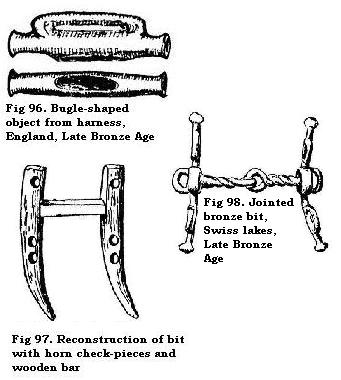 No such metal bits are known during the pure Bronze Age of continental Europe.
But from the “terremare” of Upper Italy and Middle Bronze Age deposits
in Hungary, Germany and Sweden we possess pieces of tine or horn with several
perforations that are believed to have been attached as cheek-pieces to
the ends of a bar of wood or a stout twisted strip of hide that constituted the
bit proper (Fig. 97). Similar horn cheek-pieces become quite
common in the Late Bronze Age and even reach Britain in company with other
continental types. But in Switzerland and Scandinavia by that phase of the
Late Bronze Age, termed by Reinecke Hallstatt A (Bronze Age E), and in the
contemporary Early Iron Age deposits of Upper Italy, bronze bits were being
already manufactured. These all have metal cheek-pieces, generally bent rods with loops at the sides or slits through them to take the reins (Fig. 98). Only later in the Hallstatt period do we meet examples of the modern
form of bit terminating in rings.
No such metal bits are known during the pure Bronze Age of continental Europe.
But from the “terremare” of Upper Italy and Middle Bronze Age deposits
in Hungary, Germany and Sweden we possess pieces of tine or horn with several
perforations that are believed to have been attached as cheek-pieces to
the ends of a bar of wood or a stout twisted strip of hide that constituted the
bit proper (Fig. 97). Similar horn cheek-pieces become quite
common in the Late Bronze Age and even reach Britain in company with other
continental types. But in Switzerland and Scandinavia by that phase of the
Late Bronze Age, termed by Reinecke Hallstatt A (Bronze Age E), and in the
contemporary Early Iron Age deposits of Upper Italy, bronze bits were being
already manufactured. These all have metal cheek-pieces, generally bent rods with loops at the sides or slits through them to take the reins (Fig. 98). Only later in the Hallstatt period do we meet examples of the modern
form of bit terminating in rings.
The ornaments worn during the Bronze Age are far too varied to be discussed in detail. They are, moreover, specialised into local groups that can best be mentioned later in dealing with the several cultures. Some, however, throw a unique light on cultural relations or serve as invaluable chronological guides. Such must be briefly described here.
Pins were used for fastening garments over a curiously restricted area during the earlier parts of the Bronze Age. Their use must obviously be correlated with a particular costume an untailored cloak or mantle, worn over the shoulders and fastened in front by one or two pins. As a matter of fact ancient representations or lucky finds in peat-bogs afford positive proof of the wearing of such a garb among the Sumerians and the prehistoric Danes. Pins, and the dress they imply, were worn in Mesopotamia from the earliest Sumerian times and then throughout Asia Minor and Anatolia. They were also freely used in the Cyclades and on the Greek mainland during Early Aegean times, but only very rarely and in an immature form in Crete. Pins are equally rare in centres of metallurgy connected with maritime trade westward Sicily, Sardinia, Spain and Britain. On the other hand they were adopted together with metallurgy in Central Europe, whence the local types spread widely as a result of ethnic movements.
To keep the pin in position a thread was passed through or tied on to its head,
looped round the fold of the stuff to be fastened, and the end wound round the shaft again. The devices employed for attaching the thread provide
the most workable basis for a classification of pins.
In this class the head itself is a loop through which the thread may be passed. The simplest way of making such a pin is to take a piece of wire and bend over the top end or head. Generally the head is hammered out flat before being bent over.[41] The result is termed a roll-head pin (Rollennadel) (Fig. 99). Such are found from the earliest times in Sumer and throughout the Asiatic Bronze Age province and its Central and North European extensions. A natural development of this is the shepherd's crook pin distinctive of the Bronze Age in East Central Europe. A roll-head pin might be made more ornate by simply widening the flat head. From merely broadening the head materially in this way arises the racket pin (Rudernadel}. This variant is found in Sumer before 3000BC (Fig. 101), then in the Early and Middle Bronze Ages of Hungary and Central Europe and later in the Caucasus. In the Early Bronze Age of Central Europe the decorative effect was further enhanced by trimming off the angles of the flat plate till it became a perfect circle (a little tang being left projecting opposite the shaft to form the loop), the disk pin (Scheibennadel). The disk is often decorated with an engraved cross. By casting the disk as an openwork wheel with an ear to represent the original folded loop, the wheel pin was created in the Rhine valley during the Middle Bronze Age (Fig. 102). The type was exported throughout Central Europe as far as Upper Italy, Poland and Denmark.
An earlier variant of the disk pin, also formed by trimming up a racket pin, was the trefoil pin of the Rhone valley. The bilobate and trilobate pins of the Middle Bronze Age in Upper Italy may be derived from it in the same way as the wheel pin from the disk type.
A safer loop might be produced on a wire pin by bending the top over and twisting it round the shaft, producing the knot-headed pin (Schleifennadel). The principle was known both in predynastic Egypt, in early Sumer and in prehistoric cities on the Indus. It was applied to the manufacture of pins in Cyprus and Troy II. Thence the type was diffused up the Danube to Hungary, Bohemia and Silesia, where it became common from the beginning of the age of metals and throughout the Middle Bronze Age (Fig. 103). By imitating the knot-headed pin in a casting the Aunjetitz pin (Bohmische Osennadef) was created in Bohemia. It had an inverted conical head surmounted by a cast loop or ear (Fig. 104). The ring-headed pin seems a later derivative of the same fundamental type.
In a second series the thread was passed through a hole in the pin-shaft near its head. The shaft had generally to be widened where it was pierced. In Mesopotamia by 3000BC it was hammered out flat, and the flattened surface perforated (Fig, 100). The wide flat part, often called the neck, is frequently engraved with crosses and herring-bone patterns. Above the neck the shaft was normally bent over. It was generally surmounted with a globular bead of lapis. Eyelet pins with bulbous, or in Cyprus mushroom, heads, cast in one piece with the shaft, very early found acceptance in Syria, Cyprus, Troy and South Russia. Eyelet pins did not reach Central Europe till the Middle Bronze Age, but are very characteristic of that period. The round swollen necks of these pins are decorated with just the same herring-bone and cruciform patterns as the Sumerian pins of the fourth millennium.
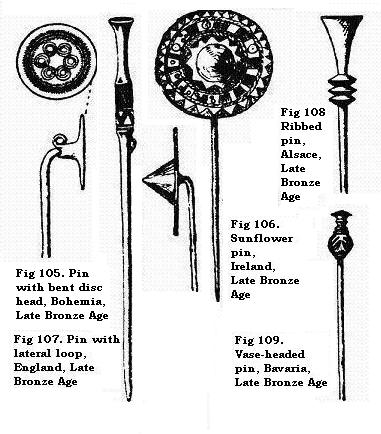 In South Germany the eyelet pins seldom have a specialised head. In Hungary, on
the other hand, they are surmounted with mushroom heads. In some mushroom pins the eyelet is formed by a spur projecting from the side of the shaft
to meet the (separately cast) head. Allied to these is a form belonging
to the very end of the Middle Bronze Age: the flat disk head is cast apart
from the shaft and with a socket fitted on to the bent shaft so that the
latter is parallel to the plane of the disk. The eye is formed by a looped
strand of finer wire, one end of which was cast on to the shaft, the other
tucked into the head's socket (Fig. 105). In its Bohemian home the disk
was generally decorated with an engraved star pattern. A variant with no
loop or eyelet reached Scandinavia in the latest Bronze Age there (Montelius IV
and V) and Great Britain. These late pins, termed sunflower pins, are
decorated only with concentric circles upon the disk (Fig. 106). The
sunflower pin is the only type at any time at all common in the British
Isles till our own Iron Age began.
In South Germany the eyelet pins seldom have a specialised head. In Hungary, on
the other hand, they are surmounted with mushroom heads. In some mushroom pins the eyelet is formed by a spur projecting from the side of the shaft
to meet the (separately cast) head. Allied to these is a form belonging
to the very end of the Middle Bronze Age: the flat disk head is cast apart
from the shaft and with a socket fitted on to the bent shaft so that the
latter is parallel to the plane of the disk. The eye is formed by a looped
strand of finer wire, one end of which was cast on to the shaft, the other
tucked into the head's socket (Fig. 105). In its Bohemian home the disk
was generally decorated with an engraved star pattern. A variant with no
loop or eyelet reached Scandinavia in the latest Bronze Age there (Montelius IV
and V) and Great Britain. These late pins, termed sunflower pins, are
decorated only with concentric circles upon the disk (Fig. 106). The
sunflower pin is the only type at any time at all common in the British
Isles till our own Iron Age began.
Allied to the pins with perforated neck is a rare type with a lateral loop on the neck. It is found occasionally in Early Bronze Age graves in North Syria. Then there are isolated examples from Bohemia belonging to the very end of the Middle Bronze Age, from Denmark later still, from the great Iron Age cemetery at Hallstatt in Upper Austria and from France undated. Yet the type has been found in Scotland in company with Middle Bronze Age rapiers and palstaves and a razor (Fig. 107).
Carefully to be distinguished from the foregoing is the “East German eyelet pin” found in the Late Bronze Age urnfields. Its distinctive feature is a lateral spur on the neck perforated with a hole parallel to the shaft. It is probably derived from a pin common in Hungary and Central Europe in the Early and Middle Bronze Ages with a bulbous head perforated with a hole running down from the crown to the side of the shaft. This type may be inspired by Syrian bulb-headed pins.
In a third family of pins the securing thread was merely twisted round the head; the latter, therefore, need not be perforated but is generally decorative. From ancient Sumerian and Early Cycladic graves come pins with animal heads, while others from Troy II were surmounted by miniature vases. In an important group extending from Turkestan to Italy the head is just a spiral disk. In some Early Cycladic specimens two spirals sprout out from the top of the shaft, and the same happens in Italy during the Middle Bronze Age and then in Central Europe, where spiral-headed pins are late in the Late Bronze Age.
Indeed, throughout continental Europe loops and eyelets went out of fashion during the Late Bronze Age. The older eyelet pins are replaced by forms, often of gigantic size, with a collar of ribs or a big head in the shape of a vase, a poppy-head, a turban or a globe. Very distinctive of the second phase of the Late Bronze Age (Kraft E) are the Swiss pins whose globular heads are adorned with inlaid “eyes”. Later, fashions changed again; the giant types disappear, and the heads of the rest shrink.
A logical corrolary of the pins kept in position by a loop of thread round the fold of clothing pierced by the pin was the safety-pin or brooch, technically known by the Latin name of fibula. There are two methods by which a safety-pin might be arrived at. You might take a wiry pin and bend back the top of the shaft over the fold of clothing to meet the lower part of the shaft and catch the point. Alternatively the thread passing through the eyelet of a toggle pin might be replaced by a length of wire which would likewise be twisted so as to catch the point. The first plan produces our safety- pin or one-piece fibula; the alternative gives rise to the so-called two-membered safety-pin. These two series seem to be independent, but both start about the same time, Middle Bronze Age or circa 1350BC, and moreover at opposite ends of the amber trade route. The one-piece safety-pin originated in Italy, Bohemia, or, on the latest theory, Mycenaean Greece; the two-membered fibula started about the same time in Denmark. It is therefore on the face of it unlikely that the two types are really autonomous and spontaneous growths.
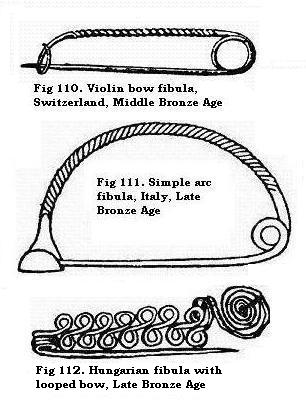 In Late Minoan Crete people wore long pins, with a twisted shaft but no
distinct head, whose upper parts were just hooked over. Blinkenberg[42] and
Myres[43] believe that these pins were turned into fibulae by the simple
expedient of bending the upper end into a hook to catch and also guard the
point. This terminal hook is thus the prototype of the catch-plate. To make a
really workable safety-pin the simple hooked end had to be modified so as
to give a protection to the point, and a spring had to be introduced to bring
the point back into the catch. The fibulae from pure LM IIIa tombs in
Greece have a bow parallel to the pin and a catch-plate formed either by
hammering out the end of the wire flat or by coiling it in a spiral (Fig. 110). Such fibulae are known as the violin-bow type and form the
starting-point for several series, developing along divergent lines in different
regions. The greater part of this evolution lies outside the scope of this
book, in the Iron Age, but some early forms may be sketched here.
In Late Minoan Crete people wore long pins, with a twisted shaft but no
distinct head, whose upper parts were just hooked over. Blinkenberg[42] and
Myres[43] believe that these pins were turned into fibulae by the simple
expedient of bending the upper end into a hook to catch and also guard the
point. This terminal hook is thus the prototype of the catch-plate. To make a
really workable safety-pin the simple hooked end had to be modified so as
to give a protection to the point, and a spring had to be introduced to bring
the point back into the catch. The fibulae from pure LM IIIa tombs in
Greece have a bow parallel to the pin and a catch-plate formed either by
hammering out the end of the wire flat or by coiling it in a spiral (Fig. 110). Such fibulae are known as the violin-bow type and form the
starting-point for several series, developing along divergent lines in different
regions. The greater part of this evolution lies outside the scope of this
book, in the Iron Age, but some early forms may be sketched here.
Violin-bow fibulae, representing the primary stage of the safety-pin, are found outside Greece in Middle Bronze Age deposits in Italy and Sicily, and rather later in Bosnia, the Tyrol and Switzerland. There are two specimens from Central Europe, alleged to come from Early Bronze Age graves, but the circumstances of their discovery are doubtful.
The changes affect principally the form of the bow, aiming at making it more ornate or capable of catching a thicker fold of clothing. In Greece during the Mycenaean period the bow was widened to a leaf-shape. Rather later a series of figure-8 twists were introduced in the wire bow. The latter type occurs on both sides of the Adriatic and in North-western Hungary (Fig. 112). In the last-named region it gave rise to a series of highly elaborate variants in the Late Bronze Age and Hallstatt period.
The main direction of evolution went towards increasing the space between pin and bow to allow of more stuff being gripped. This was effected by four methods, giving rise to four main families that constitute the second evolutionary phase: A1, prolonging the catch-plate vertically, giving the asymmetrical bow fibula; A2, bending the bow into a semicircle, producing the arc fibula; A3, twisting the bow up into an elbow and elongating the stilt, yielding the elbow and serpentine fibulae, or A4, adding coils to the spring, leading to the harp fibula. Of these only the last version preserves the spiral catch-plate. The first two, on the other hand, as well as some late violin-bow types, may have small shoulders or beads at either end of the bow.
The arc fibula (Fig. 111) appears in Greece already during LM IIIb times and in the Late Bronze Age of Italy and Bosnia, and leads to many variants in the Iron Age. The elbow fibula (a gomito] (Fig. 113) is found in Sicily in graves of the Siculan II period slightly later than those containing Mycenaean vases. In the Early Iron Age of Cyprus a kindred form is found. A rather later Sicilian type (serpeggianti ad occhio) introduces a second loop at the root of the stilt where the elbow comes. It seems influenced by a version of the arc fibula, with a loop at the base of the catch-plate, found during the Early Iron Age in Crete and Illyria. Finally the harp fibula, appearing in a rudimentary form in the latest Bronze Age of Styria, characterises the early Hallstatt period in the Eastern Alps and Lower Austria. Contemporary with it in Styria appears the earliest spectacle brooch, a type distinctive of the true Hallstatt culture and of the Geometric period in Greece. It consists of a strand of wire coiled into a pair of spiral disks ; from the centre of one the wire, sharpened to make the pin, is brought back across the other to engage in its end.
 The modifications introduced during phase III of the safety-pin's evolution
include, in the case of arc fibulae, threading beads on to the bow or
imitating such in metal bulbs cast on it (Greece and Italy), widening the
catch-plate (Greece and Illyria) or lengthening it (Italy), introducing a
second loop at the root of the catch-plate (Greece and Illyria, also Sicily),
decorating the bows with raised ribs (Upper Italy and Switzerland), etc.
The modifications introduced during phase III of the safety-pin's evolution
include, in the case of arc fibulae, threading beads on to the bow or
imitating such in metal bulbs cast on it (Greece and Italy), widening the
catch-plate (Greece and Illyria) or lengthening it (Italy), introducing a
second loop at the root of the catch-plate (Greece and Illyria, also Sicily),
decorating the bows with raised ribs (Upper Italy and Switzerland), etc.
These three stages can be approximately dated. Stage I is purely Mycenaean and accordingly begins before 1300BC; even stage II began before the end of the Mycenaean age, about 1100; while stage III was already well advanced in sub-Mycenaean times by 1000BC.
The evolution of the two-piece fibulae follows in the main the same lines as that of the one-member group. During the first or Middle Bronze Age phase (Sophus Muller[44]) the bow, either of twisted wire or leaf-shaped, is parallel to the pin and ends in two spiral disks or just two hooks. The pin is just a normal toggle pin with swollen, perforated neck and simple, club-shaped head (Fig. 114). This stage is virtually confined to Denmark. During the Late Bronze Age divergent developments set in as the device spread. In Scandinavia and North Germany the speciality of the Swiss lake-dwellings during the last phase of the Bronze Age (Kraft E).
Bracelets with spiral ends were characteristic of East Central Europe, Hungary, Galicia, East Germany and Scandinavia during the Middle and Late Bronze Age. The most handsome Middle Bronze Age type in the former area terminates in opposed spiral disks. Such rings were worn on the upper arm as the traces of wear indicate. Later Hungarian specimens, belonging already to phase E of the Bronze Age, have double-spiral ends. A variant, also with double-spiral ends but a ribbon- like body decorated with cast horizontal ribs or engraved triangles, is, however, found already in Middle Bronze Age deposits of Scandinavia, South-west Germany and Bohemia.
Two types of bracelet formed from a doubled piece of wire deserve notice. In the variety current in Central Europe from Early Bronze Age times the ends of the wire are twisted; in a British type of the Middle Bronze Age, the loop where the wire is bent back is relatively wide and the ends are twisted over and hooked into it (Fig. 120). Neither type is penannular; both approximate rather to the cylinders.
Broad armlets of plate bronze, even in width all over and decorated with cast horizontal ribs or engraved triangles, appear already in the Early Bronze Age of Central Europe. Analogous types, generally narrower and with sharper ridges, are found in contemporary deposits in France and Britain. Such wide armlets may have taken the place of the stone wrist-guards worn by the archers of the Bell-beaker culture in the Copper Age to protect them from the recoil of the bow-string. The horizontally ribbed armlet persists into the Late Bronze Age, even reaching Scandinavia. But the later Central European specimens generally have rounded ends (Fig. 119).
East of the Rhine the tendency was to replace broad armlets by cylinders. Cylinders of narrow copper ribbon had been worn even in the Copper Age and, made of stouter ribbon, appear in Early Bronze Age hoards. By the Middle Bronze Age they had become very popular, particularly in East Germany and Hungary. Here the ribbon, hammered out to nearly an inch or so in width, is decorated with punctured patterns and strengthened with a midrib which is prolonged beyond either end of the ribbon and coiled into spiral disks. The type outlasts the Bronze Age and reappears in Early Iron Age graves in Italy and the Caucasus. Cylinders of the same structure could be worn on the legs.
A series of anklets, developed in the Upper Rhine valley, is interesting owing to its well-marked typoogical evolution. The oldest form, going back to Reinecke's phase B, is a simple piece of stout wire coiled into spiral disks at either end. Next, the wire body is replaced by narrow ribbon, the spiral ends remaining wiry. Finally in phases D and E the ribbon of the body is widened and the wiry ends are bent back and carried round for one turn before being coiled into spirals (Fig. 121). This late type reaches the Upper Danube on the one hand and the French Departments of Aube, Marne and Cote d'Or on the other.
There remains a series of ornaments with wiry bodies, worn principally on the neck, which are of special importance owing to early parallels on the fringes of the Oriental civilisations. A penannular ring of stout wire with the ends hammered flat and bent back into loops (Fig. 122) is represented by a number of specimens in a hoard found at Byblos in North Syria and dated roughly about 1800BC. There are stray specimens from Egypt of a similar age, and later the type was common in the Caucasus. Just the same rings are found in the very earliest Bronze Age deposits of Hungary and Central Europe. Here they were sometimes worn as collars and used as ingots. They are therefore termed ingot torques. From Central Europe the type reached the valleys of the Rhine and Rhone. Ingot torques remained current throughout the Bronze Age, but some of the later specimens are made of twisted rectangular wire,[45] a feature also observed on certain early Syrian specimens. The effect of torsion was imitated in casting on some European examples.
A series of ingot torques diminishing in size might be fastened together by pins through the terminal loops to form gorgets. Composite gorgets of this pattern are actually found as late as phase E in South-west Germany. But imitations thereof in sheet bronze with the ends rolled up into tubes were current in Switzerland and Scandinavia during the Middle Bronze Age. The Swiss collars are decorated with engraved rectilinear patterns and maintain the same width throughout their circumference. The Scandinavian, on the other hand, are shaped so as to be widest in the middle. The earlier ones show horizontal ribs in front, reminiscent of the originally separate neck-rings, but panels at either end are richly ornamented with engraved spirals. Related to the foregoing are some collars of thin sheet gold from Brittany and Portugal. Instead of ribs, these exhibit front, slits, reproducing the effect of the originally separate rings.
A hoard found in the ruins of Troy II included a gold collar or bracelet of twisted rectangular wire with hooked ends, and a similar torque of silver wire has come to light in an Early Helladic grave on Levkas. Twisted ornaments of exactly the same pattern in bronze, or more often in gold, are common during the Middle Bronze Age in the British Isles, As an alternative to quadrangular wire, simple or compound ribbon was sometimes twisted thus (Fig. 130). The composite ribbon employed has a X-shaped section and has been made by bending a strip of gold ribbon at right angles longitudinally, joining two such strips along the keel and then twisting the result. From Great Britain these torques were exported to Brittany, Northern France and probably Scandinavia.
In the last-named country in any case a local series, in which the torsion effect is generally produced by cast ridges, began in the Late Bronze Age. It attained its richest development in that belated Bronze Age that corresponds to the Hallstatt period farther south. By then the torsion was often not continuous in the same direction, but portions of the ring had been twisted in opposite ways (Fig. 137). Finger-rings were made in the same style.
Another series of British neck ornaments belonging to the Early Bronze Age is allied in form to the Scandinavian gorgets already described. I refer to the so-called lunulae of gold. As their name implies, they are crescent-shaped pieces of thin gold plate. The horns are richly decorated with the rectilinear patterns, so characteristic of the Early Bronze Age throughout Western Europe, and terminate in flat catches. Over sixty lunulae have been found in Ireland but there are six from Scotland. The latter particularly resemble both in plan and ornament the contemporary jet necklaces found in the same country. It has therefore been suggested very plausibly that the lunulae originated in Scotland as metal copies of such necklaces, Ireland being only a secondary centre. Thence in any case they were exported to Wales, Cornwall, Brittany, Scandinavia and North Germany (Fig. 144).
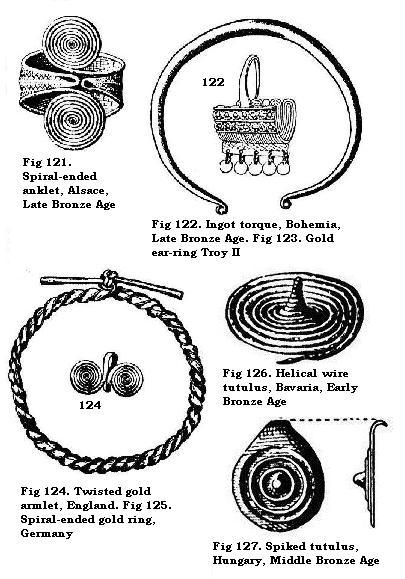 One of the simplest conceivable metal ornaments is a ring of wire or ribbon to
fit on the finger. As bone and stone finger-rings go far back in the
Stone Age, early metal copies are only to be expected. They are so widespread
as to have little cultural significance, and only a few specialised
types need mention here.
One of the simplest conceivable metal ornaments is a ring of wire or ribbon to
fit on the finger. As bone and stone finger-rings go far back in the
Stone Age, early metal copies are only to be expected. They are so widespread
as to have little cultural significance, and only a few specialised
types need mention here.
The Minoans of Crete, copying the Sumerians and Egyptians, used to mark the ownership of a packet or authenticate inscribed tablets by the impression of a seal. This was at first worn on a string, passing in one class through a loop at the back. During Middle Minoan times the loop was enlarged into a hoop to fit the finger. The oval seal part (technically called the bezel) with its long axis at right angles to the hoop, was of course beautifully engraved like the bead or button seals of gems or ivory. No seals nor signet rings were made by the European barbarians till late in the Iron Age, but in the Late Bronze Age rings of bronze leaf, generally horizontally ribbed, were made of bronze ribbon so trimmed as to be much wider at the side worn on the back of the finger than on the other. Such rings, common in South-west Germany and Switzerland, doubtless imitate Aegean signets.
A truly European ring, common in Central Europe from the Early Bronze Age onwards, was formed of a strand of gold or bronze wire doubled with the ends twisted together, coiled into a little cylinder, like the wire bracelets already mentioned. During the Middle Bronze Age a very handsome ring of bronze ribbon, terminating in opposed spiral disks, characterized the Tumulus culture of Western Germany, South-western Bohemia, Austria and Slovakia (Fig. 125). In the Late Bronze Age a more wiry version was in vogue also farther east in the urnfields of Moravia and Hungary.
In Britain we find in hoards of the Middle Bronze Age small coils of massive gold with imitation torsion that may have been worn on the fingers but possibly served as money.
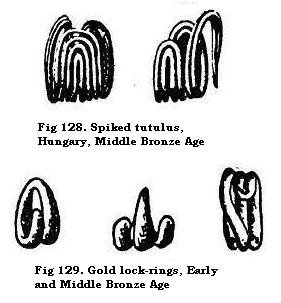 Even in Early Minoan times, buttons of some perishable material, overlaid
with gold, were being worn in Crete. The little convex disks of gold leaf,
that once had sheathed them and now alone survive, are each pierced with two
thread-holes. Similar hollow button covers, generally of bronze, appear in
Hungary even in the Early Bronze Age, and in the Middle Bronze Age become very
plentiful throughout Central Europe. In the Late Bronze Age they were
gradually replaced by a more solid button, generally flat, with a cast loop on
the back instead of the thread-holes.
Even in Early Minoan times, buttons of some perishable material, overlaid
with gold, were being worn in Crete. The little convex disks of gold leaf,
that once had sheathed them and now alone survive, are each pierced with two
thread-holes. Similar hollow button covers, generally of bronze, appear in
Hungary even in the Early Bronze Age, and in the Middle Bronze Age become very
plentiful throughout Central Europe. In the Late Bronze Age they were
gradually replaced by a more solid button, generally flat, with a cast loop on
the back instead of the thread-holes.
Buttons of stone, bone and ivory have a longer history. A very famous type, common all through Western Europe and right up to Scandinavia and the Tisza during the Copper Age, is conical and pierced on the flat side with two holes that converge to meet in a V.
Such buttons with V-perforation in jet or amber remained popular in Britain during the Early Bronze Age (Fig. 141).
Studs of stone, shaped like two disks joined by a short cylinder, were used in a rudimentary form, perhaps as lip-plugs, in prediluvian Mesopotamia and reached Crete even before the local Bronze Age began. A developed variant on this in jet was popular in Britain during the Early Bronze Age. Later metal studs of the same plan were largely manufactured in Scandinavia.
Buckles of jet were employed in Great Britain during the Early Bronze Age. They resemble an oval rod with a longitudinal slit.
For fastening the girdle very handsome clasps were used in Central and North Europe during the Middle and Late Bronze Ages. A pretty form, current chiefly in Wurrtemberg and on the Upper Rhine, was a hook of doubled wire whose ends were coiled in spiral disks. This was replaced in the Late Bronze Age by a flat metal plate, circular save for a narrow tang that was bent over to form the hook; a loop is attached to the back of the disc at the centre. In the Rhone valley during the latest Bronze Age the type was further elaborated, the tang growing into a richly decorated oval plate, while the original disk, no less ornate, developed three additional hooked tangs.
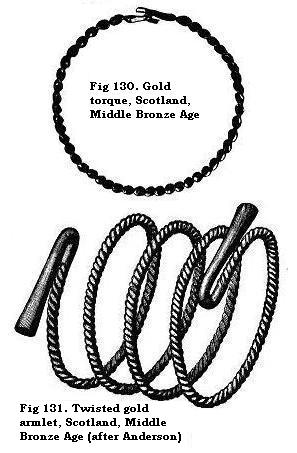 A very distinctive hook was used by Scandinavian warriors of the Middle Bronze
Age for attaching the scabbard to the girdle. The hook is massive,
cross-pieces project just below its point and its base is a solid disc.
A very distinctive hook was used by Scandinavian warriors of the Middle Bronze
Age for attaching the scabbard to the girdle. The hook is massive,
cross-pieces project just below its point and its base is a solid disc.
The girdles themselves might sometimes be all of sheetmetal. There is an example in beaten silver from Byblos in Syria. Magnificently engraved girdles of hammered bronze were being manufactured in Upper Italy at the beginning of the Iron Age, and others occur in the contemporary Bronze Age of Hungary. But normally the girdles were of leather or wool, though often decked with metal ornaments. During the Early Bronze Age of Bohemia hammered metal plates were probably thus employed; they are either shield-shaped or circular with a hollow dome-shaped boss in the centre. They are decorated with engraved triangles arranged in parallel rows or on the circumference of concentric circles. Holes near the rim enabled them to be sewn on. The latter type persists throughout the Middle Bronze Age, spreading to South-west Germany and Scandinavia, to be decorated in each region in the appropriate local style.
Early Bronze Age graves in Lower Bavaria contain extraordinary helical pyramids of coiled bronze wire, executed in a technique already exemplified on a smaller scale in the jewellery from the earliest Sumerian graves at Ur[46] (Fig. 126). Copying the helices by casting produced a metal disk with a spike in the centre surrounded by concentric ridges.[47] A small bent-over tab projects from the edge of the disk for their attach- ment to girdles or strings (Fig. 127). This “spiked tutulus” is very common in the Middle Bronze Age of Hungary and Central Europe. Scandinavian women wore a similarly shaped ornament on their girdles, but in the North the disk is often very large, 1.1 inches in diameter, and decorated with spirals (Fig. 133). In the Late Bronze Age of the North the size is still further increased, and the central spike becomes a regular little pillar surmounted with a knob. A bar across the base of the hollow pillar provides a means of attachment in lieu of the older thread-holes. Quite possibly the so-called hanging vases of the latest Bronze Age in Scandinavia are just exaggerations of this type of tutulus (Fig. 135).
Cones of rolled bronze leaf, or more elaborate versions thereof made by casting, were hung like tassels on the ends of woollen girdles.
Besides stuff and metal plate girdles, double chains were already being worn in Bohemia even in the Early Bronze Age. At that date all the links were just circular rings. In the Late Bronze Age farther west rings alternate with wide links of ribbon.
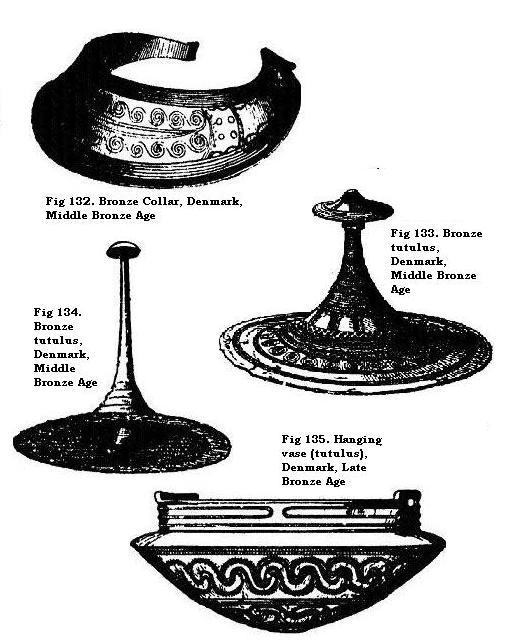 All European ear-rings and hair-rings of any interest go back in the last
resort to Mesopotamian types.[48] In the very early Sumerian graves recently
excavated at Ur of the Chaldees, Woolley found several forms that constitute
the starting points of our series. The simplest type is a penannular gold
ring, one end of which has been hammered out till it is boat-shaped while the
other is sharp. The wide end is sometimes decorated with filigree work,
at others exaggerated to monstrous proportions and duplicated. Contemporary
with these undoubted ear-rings are little open spirals, both ends of
which are boat-shaped (Fig. 129). They were perhaps twisted in the hair
over the ears and may provisionally be termed lock-rings. Identical
spiral lock-rings are known from Troy II, the Caucasus, South Russia, Hungary
and Central Europe. In the latter region a variant grew up in which one
end is bent back upon itself. There are also wiry copies influenced by the
contemporary ear-rings.
All European ear-rings and hair-rings of any interest go back in the last
resort to Mesopotamian types.[48] In the very early Sumerian graves recently
excavated at Ur of the Chaldees, Woolley found several forms that constitute
the starting points of our series. The simplest type is a penannular gold
ring, one end of which has been hammered out till it is boat-shaped while the
other is sharp. The wide end is sometimes decorated with filigree work,
at others exaggerated to monstrous proportions and duplicated. Contemporary
with these undoubted ear-rings are little open spirals, both ends of
which are boat-shaped (Fig. 129). They were perhaps twisted in the hair
over the ears and may provisionally be termed lock-rings. Identical
spiral lock-rings are known from Troy II, the Caucasus, South Russia, Hungary
and Central Europe. In the latter region a variant grew up in which one
end is bent back upon itself. There are also wiry copies influenced by the
contemporary ear-rings.
The simple ear-ring with one boat-shaped end is also found at Troy and in Hungary. At the former site barbaric exaggerations lead to the gigantic basket ear-rings. These were made by soldering on to gold bars a series of bent wire coils as shown in Fig. 123, the whole being embellished with rosettes and pendants. The barbarians of the North, who were ignorant of solder, imitated the Trojan type in two ways. In Scotland during the Early Bronze Age the basket was formed of a bent sheet of thin gold with a hook projecting from one long side. Such ear-rings have been found as British exports in Belgium and Western Poland. In the Early Bronze Age of Hungary and Bohemia the gold wire coils that formed components of the Trojan baskets were elaborated by themselves to form the ear-ring (Fig. 128). Thence they were exported to the still Neolithic inhabitants of Denmark in exchange for amber.
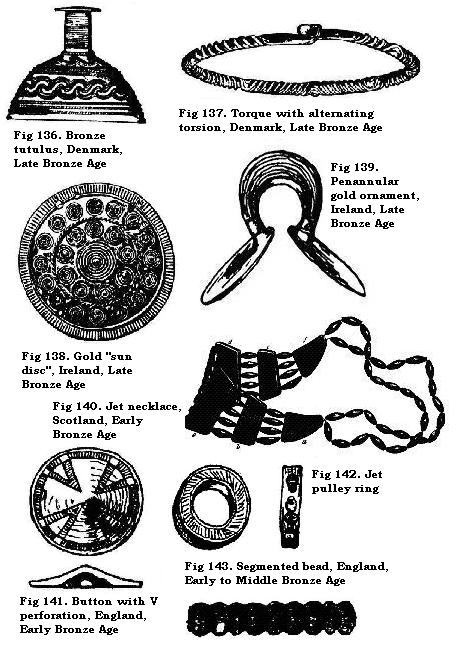 Perhaps as early as Middle Palaeolithic times men had pierced shells and strung
them together as necklaces. Upper Palaeolithic man could also carve
very neat beads out of ivory for the same purpose. The earliest Egyptians we
know, the Badarians, could already drill stone for beads and soon mastered
even such hard materials as carnelian and turquoise. An extraordinary variety
of beads and amulets were carved out of stone or ivory. In prehistoric
India and Mesopotamia, and later in Crete and the Cyclades too, stone beads
were soon very popular. Stone beads and amulets based on East Mediterranean
models and bone copies thereof were then very widely diffused throughout the
Mediterranean basin and along the Atlantic coasts to Brittany and
Ireland in the Neolithic and Copper Ages, but had practically gone out of use
before the local Bronze Age began. Along the Danube valley stone beads
had never come into vogue at all. Hence in a study of the Bronze Age in North-western and
Central Europe only amber and jet beads together with a few glazed ones
imported from the East Mediterranean need be considered.
Perhaps as early as Middle Palaeolithic times men had pierced shells and strung
them together as necklaces. Upper Palaeolithic man could also carve
very neat beads out of ivory for the same purpose. The earliest Egyptians we
know, the Badarians, could already drill stone for beads and soon mastered
even such hard materials as carnelian and turquoise. An extraordinary variety
of beads and amulets were carved out of stone or ivory. In prehistoric
India and Mesopotamia, and later in Crete and the Cyclades too, stone beads
were soon very popular. Stone beads and amulets based on East Mediterranean
models and bone copies thereof were then very widely diffused throughout the
Mediterranean basin and along the Atlantic coasts to Brittany and
Ireland in the Neolithic and Copper Ages, but had practically gone out of use
before the local Bronze Age began. Along the Danube valley stone beads
had never come into vogue at all. Hence in a study of the Bronze Age in North-western and
Central Europe only amber and jet beads together with a few glazed ones
imported from the East Mediterranean need be considered.
Amber necklaces were largely worn in Denmark, Great Britain and Central Europe, going back in the first country to early in the New Stone Age. The most popular form consisted of two or three strings of almost spherical beads connected at intervals by flat spacers. A spacer is a bead perforated with several holes, usually parallel, designed to keep the several strings of a necklace at the proper distance apart. The English and Scottish jet necklaces are similar to the foregoing but often more elaborate. Besides sphericals, thin disks, long barrel-shaped beads and flattened barrels with a little collar at either end were employed, and the spacers were cut to various shapes and diagonally perforated so that the necklace is broader on the throat than behind the neck where it was fastened (Fig. 140).
Even the earliest Egyptians could put a glaze on stone beads, and before the beginning of the dynastic epoch they had learned to cast beads of an opaque vitreous material termed faience. The secret had also been grasped in Mesopotamia and India before the beginning of the fourth millennium. Instead of casting a number of separate beads, it was found that the same effect could be obtained more cheaply by moulding a tube divided by grooves into six or eight segments. Thus arose the so-called segmented bead which may have been suggested by the manufacture of simple beads by cutting into segments and then breaking off thin tubular bones or the long roots of bovine teeth. Segmented beads of faience are in any case known from Assur in Mesopotamia as early as the third millennium BC and appear in Crete during MM III and in Egypt under the New Kingdom[49]. Analogous segmented beads of bluish faience have been found as imports in South- eastern Spain, England (Fig. 143) and Poland.
In Mesopotamia metal pendants as well as beads were hung on necklaces. These include gold hoops, bearing wire decorations, and disks engraved and inlaid, in both cases provided with a loop for suspension. We find the same idea applied in Central Europe chiefly during the Middle and Late Bronze Age. A strand of wire, coiled into two spiral disks with a loop between them like spectacles, goes back to the Copper Age, and later a small cast wheel, possibly a solar symbol, became very popular. Another pendant, very common during the Middle Bronze Age in Hungary and adjoining regions as far as the Rhine, is heart-shaped. It is actually inspired by Minoan collar segments of gold or faience bearing a hybrid pattern, termed by Sir Arthur Evans the sacral ivy-leaf.
Naturally, in addition to the foregoing, simpler ornaments such as marine shells, Dentalium tubes, bored teeth and tubes of sheetmetal or coiled wire were frequently worn.
Where metal was plentiful, it was used for the manufacture of dishes, cups and ewers and even pails and cauldrons. The majority were made of sheetmetal hammered out. Cups and dishes of precious metals or bronze could be made, as they are today, by simply beating up a sheet of metal to the desired shape. For larger vessels two or three sheets were shaped by hammering and then riveted together. Handles too were generally attached by rivets, but in the case of gold and silver vessels they might be soldered on in the Ancrient East and the Aegean. Spouts, projecting from the walls of vases in Mesopotamia and Egypt, are said to have been brazed on. Parts of the vessel might receive special treatment. The rim might be strengthened by hammering over it on either side a ribbon of metal. A ring foot can be easily made by inverting the vessel find hammering in a circular depression on the base so as to leave a fold all round, a process termed cupping the base. The handle is normally a piece of ribbon or stout wire with the ends hammered flat to receive the rivets. Metal vessels of varied shape are quite common from the beginnings of the historical period in Sumer and Egypt, at Troy II, in Copper Age graves north of the Caucasus, and in Middle and Late Minoan Crete. North of the Alps none are known before the Late Bronze Age with the exception of two gold cups from Cornwall.
The predynastic Egyptians were very skilled in grinding vases out of even the hardest stones, and stone vessels were also freely used in early Sumer, in Crete from Early Minoan times and in the Cyclades. This material was not adopted for the manufacture of vessels north of the Alps save in Britain. And the small group of English cups of shale or amber, belonging mainly to the Middle Bronze Age, bear no obvious relation to any East Mediterranean form, being equipped with handles and turned on a lathe. Their prototypes are to be sought in woodwork.
Bronze Age pottery exhibits such a variety of forms and ornaments that it must
be described in connection with the several cultural groups which it
serves to define. Technically, it does not differ in any essential principle from Stone Age wares save in the Ancient East and the Aegean. There the
application of the wheel, already described, gave the potter opportunities for
all sorts of experiments. In the Aegean too a glaze paint, that is, a paint
containing silicates that fuse and vitrify during the firing of the vase,
had been invented in Early Minoan Crete and diffused thence to the Early
Cycladic and Helladic folk. It enabled the potter to produce lustrous patterns
without burnishing the whole surface. Apart from these inventions and even
north of the Alps, Bronze Age pottery exhibits some features, notably
handles and spouts, apparently unknown or at least very rare in pure Neolithic
times.
1. British Museum. A Guide to the Antiquities of the Bronze Age. 1920
1A. EVANS, JOHN. Ancient Bronze Implements of Great Britain. London, 1881
2. CHILDE. The Most Ancient East. London, 1928
3. CHILDE. The Danube in Prehistory. Oxford, 1929
4. MULLER, SOPHUS. In MS AN. 1914-15
5. PETRIE, Tools and Weapons. London, 1917. For CHAPTER I especially
6. PETRIE, Tools and Weapons. London, 1917. For CHAPTER I especially
7. CHILDE. The Most Ancient East. London, 1928
8. Articles by TARAMELLI and BOSCH-GIMPERA in Il Convegno Archeologico in Sardegna, Reggio nell’ Emilia, 1929
9. EVANS, JOHN. Ancient Bronze Implements of Great Britain. London, 1881
10. CHILDE. The Most Ancient East. London, 1928
11. CHILDE. The Danube in Prehistory. Oxford, 1929
12. EVANS, A.J. The Palace of Minos at Knossos. London, 1921 ff
13. CHILDE. The Danube in Prehistory. Oxford, 1929
14. GJERSTAD. Studies on Prehistoric Cyprus. Uppsala, 1926
15. KRAFT. Die Kultur der Bronzezeit in Suddeutschland. Tubingen, 1925
16. HALL, H. R. The Civilisation of Greece in the Bronze Age. London, 1928
17. REINECKE. In Altertumer unserer heidnischen Forzeit. v
18. British Museum. A Guide to the Antiquities of the Bronze Age. 1920
19. KOSSINNA. Die deutsche Vorgeschichte, eine hervorragend nationale Wissenschaft. 1922
20. MULLER, SOPHUS. In MS AN. 1914-15
21. PARKER-BREWIS. “The Bronze Sword in Great Britain”. Arch. LXXIII
22. PEAKE. The Bronze Age and the Celtic World. London, 1922
23. EVANS, A.J. The Palace of Minos at Knossos. London, 1921 ff
24. CHILDE. The Most Ancient East. London, 1928
25. TALLGREN. La Pontide prescythique (Eurasia Septentrionalis Antiqua, II). Helsingfors, 1926
26. PETRIE, Tools and Weapons. London, 1917. For CHAPTER I especially
27. British Museum. A Guide to the Antiquities of the Bronze Age. 1920
28. DORPFELD. Alt-Ithaka. Munich, 1927
29. GREENWELL. “The Origin of the Bronze Spearhead”, Arch. LXI
30. COFFEY. The Bronze Age in Ireland, Dublin, 1913
31. Huelva. Real.s.v
32. TALLGREN. La Pontide prescythique (Eurasia Septentrionalis Antiqua, II). Helsingfors, 1926
33. PETRIE, Tools and Weapons. London, 1917. For CHAPTER I especially
34. SCHMIDT, H. Schliemanns Sammlung Trojanishcher Altertumer. K. Museen zu Berlin, 1902
35. CHILDE. The Dawn of European Civilisation. London, 1924
36. CHILDE. The Danube in Prehistory. Oxford, 1929
37. MONTELIUS. Dievorklassische Chronologie ltaliens. Stockholm, 1912
38. CALLANDER. “Scottish Bronze Age Hoards”. PSAS. LVII
39. CHILDE. The Most Ancient East. London, 1928
40. PETRIE, Tools and Weapons. London, 1917. For CHAPTER I especially
41. At first this flat head may just have been part of the original ribbon from which the wire was managed by the torsion process.
42. BLINKENBERG. Fibules greeques et orientates. Copenhagen, 1926
43. MYRES, J.L. Who were the Greeks? Berkeley, 1930
44. MULLER, SOPHUS. In MS AN. 1914-15
45. The name torque, derived from the Latin torqueo, I twist, should strictly be applied only to such twisted rings, but is in practice used for all neck-rings whether smooth or twisted.
46. CHILDE. The Most Ancient East. London, 1928
47. KRAFT. Die Kultur der Bronzezeit in Suddeutschland. Tubingen, 1925.
48. CHILDE. The Most Ancient East. London, 1928
49. EVANS, A.J. The Palace of Minos at Knossos. London, 1921 ff